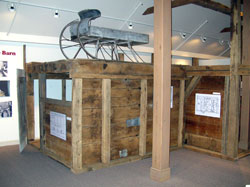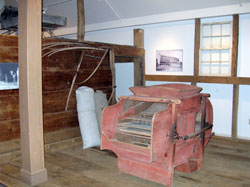 The Mennonite Heritage Center, 565 Yoder Road, Harleysville, announces a new exhibit As Large as Palaces: Pennsylvania German Barns. The exhibit focuses on the history, functions, and architecture of the beautiful nineteenth century Pennsylvania German barns in southeastern Pennsylvania. As Large as Palaces features a reconstruction of an original barn’s threshing floor and bents (or framing sections), along with a granary and a recreation of cow stable from the lower level of a barn. Vintage barn photographs and diagrams of barn architecture, as well as examples of 19th century farm tools and equipment show how barns were designed to house animals and provide for crop processing and storage. The exhibit will run until October 29, 2007.
The Mennonite Heritage Center, 565 Yoder Road, Harleysville, announces a new exhibit As Large as Palaces: Pennsylvania German Barns. The exhibit focuses on the history, functions, and architecture of the beautiful nineteenth century Pennsylvania German barns in southeastern Pennsylvania. As Large as Palaces features a reconstruction of an original barn’s threshing floor and bents (or framing sections), along with a granary and a recreation of cow stable from the lower level of a barn. Vintage barn photographs and diagrams of barn architecture, as well as examples of 19th century farm tools and equipment show how barns were designed to house animals and provide for crop processing and storage. The exhibit will run until October 29, 2007.
As Large as Palaces takes it title from eighteenth century mapmaker Lewis Evans who commented about Pennsylvania farmsteads that “It is pretty to behold our back Settlements, where the barns are as large as pallaces, while the Owners live in log hutts; a sign tho’of thriving farmers.†The early European emigrants placed priority on barns because of their good animal husbandry – shelter was needed for animals and to store hay and grain for feed. Early barns in southeastern Pennsylvania during the settlement period were usually rough structures of logs and thatched roofs, but by the mid-eighteenth century, the Pennsylvania German barn had evolved into a substantial building of log or stone. As more and more acres came under cultivation and production increased, more storage was needed. By the mid-nineteenth century farmers built even larger barns, no longer of log, but of frame, brick and stone.
The unique style of Pennsylvania German barns was influenced by both practical needs and European traditions, particularly Swiss (Sweitzer) barns. Pennsylvania German barns are noted for their two-level post and beam architecture and for the earthen bank or barn bridge on the back-side of the building. The multi-level design was a practical design. The lower level was used to house animals. The upper level was used to store hay and straw in the mow and grain in an enclosed granary with room to accommodate grain threshing and unloading hay in the center bay. Feed from the top level could be easily thrown down to the stabled animals below. The barn bridge helped insulate the bottom level of the barn and allowed hay wagons to be driven into the upper level for unloading. Another identifying characteristic of a Pennsylvania barn was the forebay or overhang on the bottom side of the barn that shaded the stable area in summer and also provided protection in the winter.
 Farm life centered around the barn and family members spent many hours milking cows, feeding animals, assisting with calving, loading and unloading hay, and threshing grain. Throughout the eighteenth and nineteenth centuries, agriculture thrived, grew, and changed but the barn remained the hub of farm life. Increasing mechanization and sanitary standards brought more changes to farming in the twentieth century and barns were renovated to deal with the changing times. Stanchions and cement floors replaced wooden stables and earthen floors. Milking machines and farm machinery increased production and decreased some of the grueling hand labor but many people still have memories of going out to the barn to milk on an icy winter morning or of unloading hay in the heat of the summer.
Farm life centered around the barn and family members spent many hours milking cows, feeding animals, assisting with calving, loading and unloading hay, and threshing grain. Throughout the eighteenth and nineteenth centuries, agriculture thrived, grew, and changed but the barn remained the hub of farm life. Increasing mechanization and sanitary standards brought more changes to farming in the twentieth century and barns were renovated to deal with the changing times. Stanchions and cement floors replaced wooden stables and earthen floors. Milking machines and farm machinery increased production and decreased some of the grueling hand labor but many people still have memories of going out to the barn to milk on an icy winter morning or of unloading hay in the heat of the summer.
Barns represented community life too. Barn raisings were an event for the entire community – men worked together to construct and put the barn framework in place and women provided a hearty meal for the laborers. Barns were also used for social functions – barn dances were an opportunity for Saturday evening fun. The hay mow was a place for children to explore on a Sunday afternoon or a retreat for solitary contemplation and prayer. Today the landscape of southeastern Pennsylvania is changing rapidly and Pennsylvania German barns are no longer a common sight. The barns that remain are a legacy to our communities – their architecture and building materials convey a sense of history, craftsmanship, and hard work.
The Mennonite Heritage Center invites individuals, groups, and children’s groups to visit the barn exhibit. Call 215.256.3020 ext. 114 for more information about scheduling a group visit. Special speakers and programs are also planned throughout the year. A “Farm and Garden Day†will be held on Saturday, April 28, 2007. Historian Alan Keyser will speak on “The Functions and Activities of a Nineteenth Century Barn†on May 17 at 7:30 pm. A day long tour of area barns is planned for June 16, 2007. Jeff Marshall, Heritage Conservancy (Doylestown, Pa.), barn preservation specialist, will speak on “Barn Architecture and Barn Preservations Options†on September 18, 2007 at 7:30 pm.
The Mennonite Heritage Center is located at 565 Yoder Road, Harleysville, Pa. Exhibit hours are Tues-Fri 10 am to 5 pm, Sat 10 am to 2 pm, Sun. 2 to 5 pm. For information on this and other events and exhibits, check the Mennonite Heritage Center web site: www.mhep.org, email: info@mhep.org, or call 215-256-3020.
The opinions expressed in articles posted on Mosaic’s website are those of the author and may not reflect the official policy of Mosaic Conference. Mosaic is a large conference, crossing ethnicities, geographies, generations, theologies, and politics. Each person can only speak for themselves; no one can represent “the conference.” May God give us the grace to hear what the Spirit is speaking to us through people with whom we disagree and the humility and courage to love one another even when those disagreements can’t be bridged.
